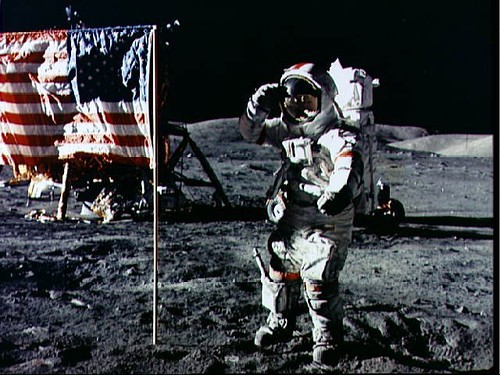 |
| FlyingSinger, Flickr.com, CC BY 2.0 |
The cultural resource or heritage management is in charge of evaluating the significance of space sites and artifacts according to national and inter-national preservation laws. They examine how and why these outer space artifacts and sites of our recent history should be preserved for our future generations to view. For example, they decide on whether or not the site where Neil Armstrong landed on the Moon should be preserved so that we can see the first steps man made on the moon.
 |
| NASA Goddard Photo and Video, Flickr.com, CC BY 2.0 |
People like Beth O’Leary, an associate professor of Anthropology at New Mexico State University (NMSU) and co-editor of the handbook of space engineering, archaeology, and heritage, have dedicated themselves to preserve the many artifacts on the moon. One site she had dedicated herself in watching over is the flag and the footprint of Neil Armstrong left to prove he walked on the Moon. With a grant from NASA, O’Leary helped establish the Lunar Legacy Project; which aims to preserve the historical information found at Tranquility Base. She previously stated, “We need to prepare for the future because in fifty years many travelers may go to the moon, if the site is not protected, what will be left?”
There are artifacts left behind in space other than those found on the Moon and Mars, but some of them threaten the safety of Earth. Since some of these artifacts, like low orbiting satellites and stations, currently run the risk of impacting each other and other space objects; instead of them being labeled as our cultural heritage they are considered space junk. An informed decision on the risk of letting them continue to orbit or destroying them should be made while keeping their international and historical significance in mind.
Because of the global safety dilemma there is the potential of parts of space archaeological record being destroyed and possibly forgotten. The question of which artifacts are culturally important and which are not is being asked, but how exactly are we suppose to answer. As humans living in the world today we have no idea what artifacts will have relevance and which will not in the future. Making us run the risk of leaving a missing link in our record of space exploration. For example, Wall-E from the Disney movie, feeds his curiosity by examining items he comes across in the mountains of trash left by the humans. He finds a woman’s bra and begins examining it and placing it on his head as a hat and over his eyes as a blindfold, confused about what the primary purpose of his finding was. Will we be just as confused when looking at the space artifacts we left behind in the future?
 |
| Idaho National Library, Flickr.com, CC BY 2.0 |
Because of the global safety dilemma there is the potential of parts of space archaeological record being destroyed and possibly forgotten. The question of which artifacts are culturally important and which are not is being asked, but how exactly are we suppose to answer. As humans living in the world today we have no idea what artifacts will have relevance and which will not in the future. Making us run the risk of leaving a missing link in our record of space exploration. For example, Wall-E from the Disney movie, feeds his curiosity by examining items he comes across in the mountains of trash left by the humans. He finds a woman’s bra and begins examining it and placing it on his head as a hat and over his eyes as a blindfold, confused about what the primary purpose of his finding was. Will we be just as confused when looking at the space artifacts we left behind in the future?
For More Information
- http://www.academia.edu/
167541/The_archaeology_of_ orbital_space - http://alumnae.mtholyoke.edu/
blog/beth-oleary-74-space- archaeologist-lauds-lunar- legacy/ - http://www.archaeologyexpert.
co.uk/ archaeologyfromouterspace.html - https://theconversation.edu.
au/saving-space-junk-our- cultural-heritage-in-orbit- 6025 - http://archive.archaeology.
org/0411/etc/space.html - https://wp.
carleton.edu/ historicalarchaeology/2012/11/ 11/wall-e-and-archaeology- match-made-in-heaven-or-just- outer-space/ - http://articles.latimes.com/
2009/jun/01/opinion/oe-walsh1 - http://www.nasa.gov/centers/
goddard/news/releases/2013/13- 013.html




0 comments:
Post a Comment